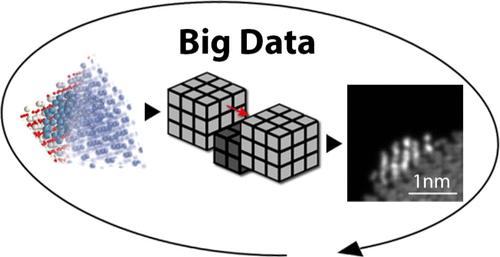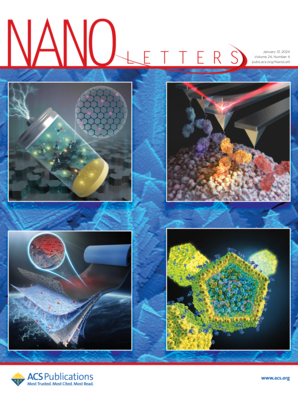Improving Nanoparticle Size Estimation from Scanning Transmission Electron Micrographs with a Multislice Surrogate Model
IF 9.6
1区 材料科学
Q1 CHEMISTRY, MULTIDISCIPLINARY
引用次数: 0
Abstract
The computational cost of simulating scanning transmission electron microscopy (STEM) images limits the curation of large enough data sets to train accurate and robust machine learning networks for deep feature extraction from atomically resolved STEM images. For nanoparticle size estimation in particular, a diverse data set is essential due to the large variations in size, shape, crystallinity, orientation, and dynamical diffraction effects in experimental data. To address this, we train a 3D convolutional neural network to predict STEM images from voxelized atomic models, achieving a 100x speed-up compared to traditional multislice simulations while maintaining high image quality. We then generate a data set of 100.000 synthetic multislice images and investigate the performance of different size-estimator architectures as a function of training set size. A ResNet18-based model trained on 4000 real and 100.000 synthetic images is found to perform the best, reducing the median size-estimation error from 9.89% without synthetic data to 5.26%.

求助全文
约1分钟内获得全文
求助全文
来源期刊

Nano Letters
工程技术-材料科学:综合
CiteScore
16.80
自引率
2.80%
发文量
1182
审稿时长
1.4 months
期刊介绍:
Nano Letters serves as a dynamic platform for promptly disseminating original results in fundamental, applied, and emerging research across all facets of nanoscience and nanotechnology. A pivotal criterion for inclusion within Nano Letters is the convergence of at least two different areas or disciplines, ensuring a rich interdisciplinary scope. The journal is dedicated to fostering exploration in diverse areas, including:
- Experimental and theoretical findings on physical, chemical, and biological phenomena at the nanoscale
- Synthesis, characterization, and processing of organic, inorganic, polymer, and hybrid nanomaterials through physical, chemical, and biological methodologies
- Modeling and simulation of synthetic, assembly, and interaction processes
- Realization of integrated nanostructures and nano-engineered devices exhibiting advanced performance
- Applications of nanoscale materials in living and environmental systems
Nano Letters is committed to advancing and showcasing groundbreaking research that intersects various domains, fostering innovation and collaboration in the ever-evolving field of nanoscience and nanotechnology.
 求助内容:
求助内容: 应助结果提醒方式:
应助结果提醒方式:


